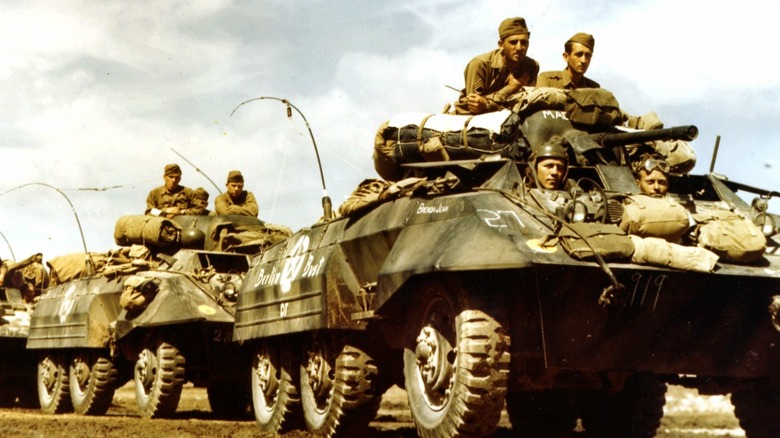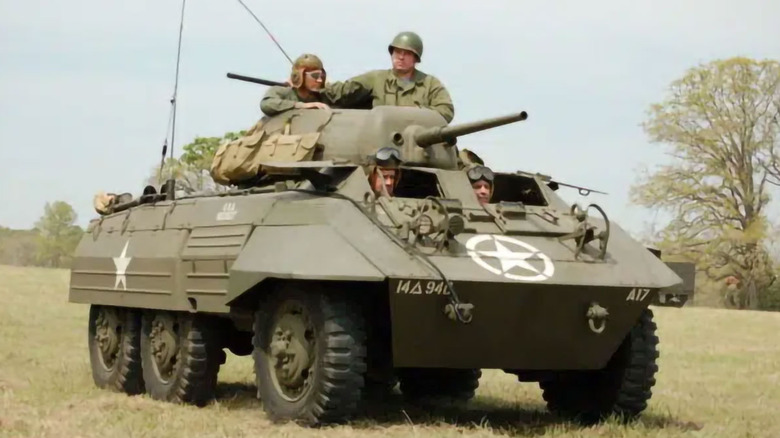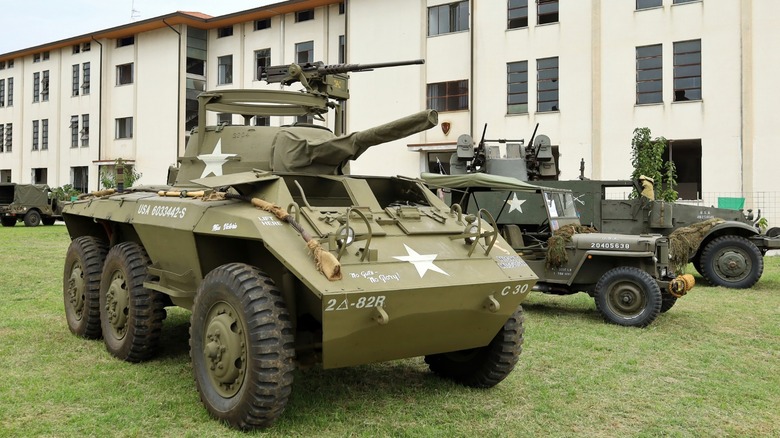Why The M8 Greyhound Was Retired From The U.S. Military
The M8 light-armored car, better known as the M8 Greyhound, was an armored vehicle used by the U.S. military during World War II. Developed and produced by the Ford Motor Company, over 8,500 M8s were manufactured between 1943 and 1945. Though it was clear there were serious core deficiencies with the M8 Greyhound, it would continue to be used heavily in the Pacific Theater during World War II and then again in the Korean War.
The 6x6 M8 Greyhound would go on to influence modern armored personnel carriers used by U.S. Light Armored Reconnaissance Battalions (LAR) today. Modern evolutions of the lightly armored design can be seen in vehicles like the Stryker light-armored vehicles and the LAV-25. While the M8 Greyhound was one of the fastest armored vehicles of its day, a few key design flaws saw the need for it to be completely re-purposed from its initial intent.
Though the timing and the eventual end of World War II would see the production and development of the M8 Greyhound scrapped, the armored car will go down as one of the earliest U.S. iterations of lightly armored transport vehicles that are still used today.
The M8 Greyhound was initially designed as an anti-tank vehicle
Though it makes little sense in retrospect — considering the heavy armor of Panzer tanks in the European Theater — the M8 Greyhound was originally designed as a tank destroyer. Produced by Ford for the U.S. military as a response to German armor, the M8 would fail its original mission. Its main 37 mm cannon wasn't powerful enough to penetrate the heavy armor of the Panzer tanks developed by Axis forces, which led it quickly to be redesignated as a reconnaissance vehicle.
Unlike other armored vehicles of the time, the M8 Greyhound was fast, reaching 56 miles per hour with its 110-horsepower Hercules JXD engine. At 8.2 tons, 16.5 feet long, and over 8 feet wide, it was fairly light for a vehicle of its size while still managing to host a four-person crew. In addition to the vehicle's main 37 mm cannon, it also had a .30 caliber machine gun and an optional .50 caliber machine gun that could be mounted on the rear of the turret.
Unfortunately, the speedy, lightly-armored M8 Greyhound had one glaring issue besides its relatively weak main cannon that would cause it to be far less effective on the battlefield. This inefficiency would eventually lead the project to be phased out, with more contemporary lightly-armored vehicles, like the LAV series, becoming the U.S. standard in the 1980s.
One aspect of the M8 left it highly vulnerable
The first M8 would see action in 1943 when Allied forces invaded Sicily, Italy. As a reconnaissance vehicle, the M8 Greyhound was incredibly fast, but only under the right conditions. Unlike the best all-terrain military tanks used today, additional pressure on the tank's suspension systems caused it to be limited to mostly paved roads. However, this didn't stop Ford from showcasing its offroad capabilities in old video reels, where the vehicle can be seen rocking up and down when going over hills. This lack of an adequate suspension system limited the M8's movements and made it more predictable and vulnerable, as it was limited to street usage.
The M8 also lacked the heavy armor required to protect it from larger cannons, tank fire, and, most importantly, landmines. The vehicle's armor was graded to protect the operators from small arms fire and shrapnel only. The M8 Greyhound's floor armor was particularly thin, at just .25 inches thick, leaving little protection against the tricky minefields set up by the enemy.
Though production for the M8 Greyhound had long stopped by the time of the Korean War in 1950, the M8 would still be deployed for the United States troops during that conflict. Later, the vehicle would be used by countries outside the U.S. into the 21st Century. Ultimately, the M8 Greyhound served its temporary use in the Pacific Theater but was eventually phased out due to waning interest in military investment post World War II and the invention of more effective vehicles in later decades.


